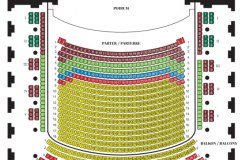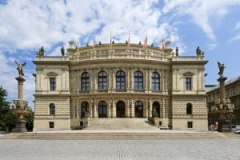Czech Philharmonic
Mo | Tu | We | Th | Fr | Sa | Su |
Program and cast
April 30, 2025; May 1, 2025; and May 2, 2025
Alžběta Poláčková: soprano
Jiří Brückler: baritone
Jan Šťáva: bass
Prague Philharmonic Choir
Lukáš Vasilek choirmaster
Czech Philharmonic Youth Orchestra
Jakub Hrůša conductor
Czech Philharmonic
*The Czech Philharmonic Youth Orchestra is playing Scheherazade by Rimsky-Korsakov.
Programme
Nikolai Rimsky-Korsakov: Scheherazade, symphonic suite, Op. 35
Josef Suk: Epilogue, symphonic composition for orchestra, large and small mixed choir, soprano, baritone, and bass, Op. 37
September 25, 2025, and September 26, 2025 | Season Opening Concert
Seong-Jin Cho, piano
Semyon Bychkov, conductor
Czech Philharmonic
Programme
Maurice Ravel
Piano Concerto in G major
Pyotr Ilyich Tchaikovsky
Symphony No. 5 in E minor, Op. 64
Duration: 120 minutes
November 16, 2025, and November 17, 2025 | Velvet Revolution Concert
Lucy Crowe, soprano
Okka von der Damerau, mezzo-soprano
Prague Philharmonic Choir
Lukáš Vasilek, choirmaster
Zubin Mehta, conductor
Czech Philharmonic
Programme
Gustav Mahler
Symphony No. 2 in C minor “Resurrection”
Duration: 120 minutes
December 31, 2025 - 3:00 PM | New Year’s Eve Afternoon Concert
January 1, 2026 - 3:00 PM | New Year’s Afternoon Concert
January 1, 2026 - 8:00 PM | New Year’s Galaconcert
Barbora Trnčíková, oboe
Kateřina Javůrková French, horn
Walter Hofbauer, trumpet
Robert Kružík, conductor
Czech Philharmonic
Marek Eben host (only 1. Jan 2026)
Programme
Dmitri Shostakovich
Festive Overture, Op. 96
Maurice Ravel
Alborada del gracioso
Paul Dukas
Villanelle for French horn and orchestra
Claude Debussy (arr. by André Caplet)
Clair de lune
Ennio Morricone
Gabriel’s Oboe, main theme from the film The Mission
Arturo Márquez
Danzón No. 2
Oskar Böhme
Tarantella “La Napolitaine” for trumpet and orchestra, Op. 25
Pietro Mascagni
Cavalleria rusticana, intermezzo from the opera
Leonard Bernstein
Candide, overture to the operetta
Duration: 120 minutes
Rudolfinum
The Rudolfinum, one of the most noteworthy buildings in Prague, was built between 1876 and 1884 according to the designs of architects Josef Zítek and Josef Schulze. Originally intended as a multipurpose cultural building in Prague, the Rudolfinum was inagurated on February 7, 1885. It carried out its mission until 1919, when it was converted to the House of Commons of the Czechoslovak Republic. Concert activity was restored to the Rudolfinum during the German occupation, but full rehabilitation, particularly of the gallery, did not take place until 1992. After a general reconstruction by architect Karel Prager in 1992, the Rudolfinum became the home of the Czech Philharmonic and the Rudolfinum Gallery.
Dvorana – Ceremony Hall
The central space in the gallery portion of the Rudolfinum was designed by Josef Zítek and Josef Schulz as an entrance hall to the art gallery. After 1918, however, this space was converted into a parliamentary cafeteria, and after World War II it served as a gymnasium for the Prague Conservatory. At the end of the 1980s, Ceremony Hall was threatened with reconstruction – but plans to tear down the main staircase to make room for another concert hall did not go through, and the hall retained its original appearance. Of particular interest in Ceremony Hall are 25 empty spaces on its walls, which were originally intended to be filled in with frescos. The majority of the eminent Czech painters, however, boycotted the 1891 fresco competition in protest over the large number of German artists involved in the construction of the Rudolfinum.
Dvořák Hall
The Czech Philharmonic took the stage in this world-famous concert hall in 1896, performing for its first-ever concert under the baton of Antonín Dvořák himself. The hall remained a space for concerts and performances until 1918, at which time it became a boardroom for the new parliament of the Czechoslovak Republic. The stage and the organ loft became a tribunal (garnished with a statue of President T.G. Masaryk), from which parliamentary leaders presided over proceedings. The hall's original character (and purpose) was restored
in 1940–1942 according to a project conceived by Antonín Engel and Bohumír Kozák, and it has remained in this form through to the present. In accordance with Josef Zítek and Josef Schulz's original proposal, the central visual element in the hall is an organ, which was made in Frankfurt, Germany. During the hall's stint as a parliamentary meeting place, the organ was housed in Brno. When it returned to the Rudolfinum in 1940, its register was extended. Dvořák Hall's final update took place in 1992 when the entire Rudolfinum building underwent reconstruction.
When travelling by public transport, get off at the Staroměstská metro station (Line A), tram stop (trams nos. 17, 18 and 53) or bus stop (no. 207).
Parking is available at the underground parking facility on Jan Palach Square. The facility is not part of the Rudolfinum premises.

 EN
EN DE
DE IT
IT FR
FR ES
ES RU
RU JP
JP RO
RO
 Seating plan
Seating plan 